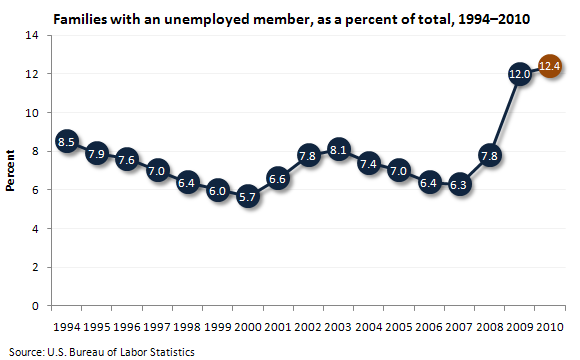March 28, 2011 (The Editor’s Desk is updated each business day.)
Employment characteristics of families, 2010
In 2010, 12.4 percent of families included an unemployed person—its highest level since the data series began in 1994. The proportion of families with an unemployed member in 2010 was up from 12.0 percent in 2009 and nearly double the 6.3 percent recorded in 2007. (The most recent recession began in December 2007 and ended in June 2009 according to the National Bureau of Economic Research.)

[Chart data]
Among families with an unemployed member in 2010, 67.7 percent also had an employed member, down from 68.6 percent in 2009 and 71.2 percent in 2007. Among married-couple families with an unemployed member in 2010, 79.4 percent contained at least one employed member.
In 2010, among married-couple families with children, 95.7 percent had an employed parent, unchanged from the prior year. The share of married-couple families where both parents worked fell to 58.1 percent in 2010 from 58.9 percent in 2009.

[Chart data]
In 2010, the mother was employed in 67.0 percent of families maintained by women with no spouse present, down from 67.8 percent in 2009. The father was employed in 75.8 percent of families maintained by men with no spouse present in 2010, little changed over the year.
These data are from the Current Population Survey. To learn more, see "Employment Characteristics of Families in 2010" (HTML) (PDF), news release USDL-11-0396. A family is a group of two or more persons residing together who are related by birth, marriage, or adoption.
Related TED articles
Employment |
Men |
Unemployment |
Women
Of interest
Spotlight on Statistics: National Hispanic Heritage Month
In this Spotlight, we take a look at the Hispanic labor force—including labor force participation, employment and unemployment, educational attainment, geographic location, country of birth, earnings, consumer expenditures, time use, workplace injuries, and employment projections.
.
Read more »

